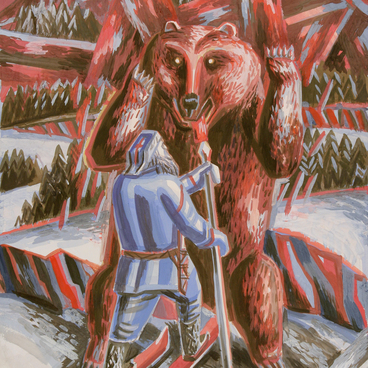Mikhail Petrovich Tsybasov was a painter, graphic artist, illustrator, and movie set designer. From 1924 to 1927, he studied at the Leningrad Art and Industrial College. In 1926, he became a member of the association “Masters of Analytical Art”, also known as “Filonov’s School”. A year later, he began to actively participate in exhibitions. In 1935, he joined the production company Lenfilm as a set designer. He was also a veteran of the Great Patriotic War.
In 1931, on the initiative of Ivan Mikhailovich Maisky, Envoy of the USSR in Finland, the Academia Publishing House decided to publish an illustrated edition of the “Kalevala”. Pavel Nikolayevich Filonov was initially chosen to design the edition, but he declined, preferring to involve his own students in the project. He formed a team of 13 artists and supervised the process of creating each illustration with great care.
Mikhail Tsybasov, as Pavel Filonov later recalled, “carried all the work on his shoulders”. Drawings by Alisa Poret, Mikhail Tsybasov and Tatyana Glebova, shown at the publishing house, determined the fate of the “Kalevala”. As a result, an example of new aesthetics, a new form of graphic art emerged. It was based on the general concept and strict canon set by Pavel Filonov. The feeling of an archaic world was brought about by the forms of “neoprimitive” drawing, roughness and static analytic elements. Most of the illustrations were created by Mikhail Tsybasov. His works are also considered the most talented.
Tsybasov immerses the viewer in an atmosphere of ancient runes and the era of mythological heroes. One of the illustrations depicts a meeting of two wizards: the wise old Wainamoinen and the ambitious young Youkahainen. The experience and wisdom of the elder wizard will prevail, while the desires of the younger wizard will lead to his defeat and family tragedy.
The artist conveys the intense struggle between
characters through the use of expressive intertwining lines that depict arcs,
shafts, reins, and horse backs, as well as the silhouettes of people. In the
center of the composition, the “master of analytical art” draws a collision
between horses, whose snouts in a grotesque turn resemble those of dragons. The
battle between two male protagonists still lies ahead, but this episode is also
a significant starting point for the narrative. It is no coincidence that the
emphasis in this artwork is placed on the animals, details of weapons, and the
contrast between the intensity of the struggle and the tranquility of the
surrounding landscape. In this silent setting of northern forests and swamps, a
chain of events begins that will unfold into an epic drama.



